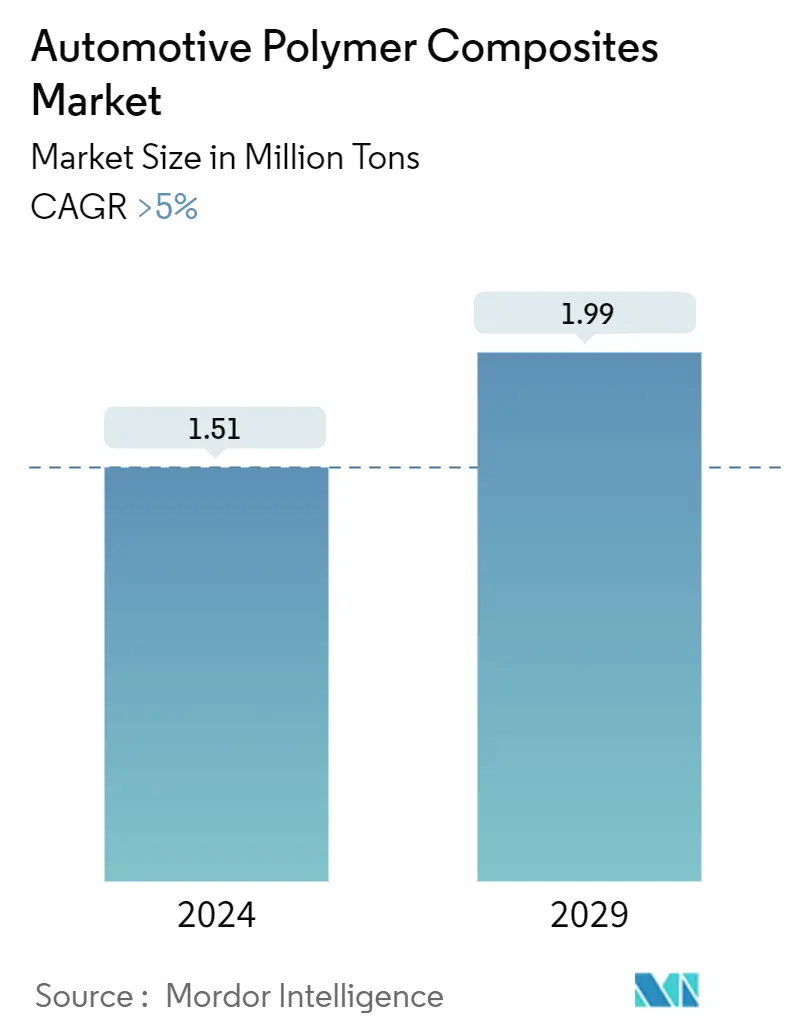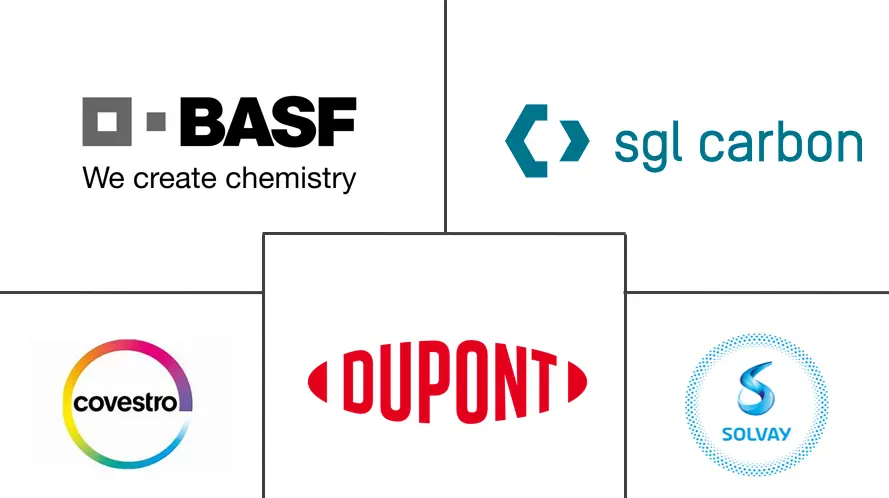Market Size of Automotive Polymer Composites Industry

| Study Period | 2019 - 2029 |
| Base Year For Estimation | 2023 |
| Forecast Data Period | 2024 - 2029 |
| CAGR (2024 - 2029) | 5.00 % |
| Fastest Growing Market | Asia Pacific |
| Largest Market | Asia Pacific |
Major Players
*Disclaimer: Major Players sorted in no particular order |
Automotive Polymer Composites Market Analysis
The Automotive Polymer Composites Market size is estimated at 1.51 Million tons in 2024, and is expected to reach 1.99 Million tons by 2029, growing at a CAGR of greater than 5% during the forecast period (2024-2029).
The COVID-19 pandemic significantly impacted the automotive polymer composites market by disrupting the supply chain, causing production to slow down and shut down and an economic downturn. By overcoming the remaining challenges and capitalizing on the market trends, the automotive polymer composites market is poised for a positive future, revolutionizing the automotive industry with its lightweight, high-performance materials.
Lighter vehicles are more fuel-efficient and emit less pollution, which is driving demand for automotive polymer composites in the global market, which are lighter than traditional materials such as steel and aluminum.
On the flip side, compared to traditional materials like steel and aluminum, the processing and manufacturing of polymer composites often involve complex and labor-intensive techniques, driving up costs and is expected to act as a restraint for the automotive polymer composites market.
Innovations in robotics, automation, and digitalization are streamlining composite production processes, reducing costs and lead times, and creating exciting possibilities for the global market.
Asia-Pacific is estimated to dominate the market, with the most significant consumption coming from countries like China, India, Japan, and South Korea.
Automotive Polymer Composites Industry Segmentation
Automotive polymer composites are materials made by combining polymers (plastics) with reinforcing fibers, such as glass, carbon, or aramid. This creates a material that is stronger, lighter, and more durable than the polymer itself.
The Report Covers Automotive polymer composites Market Analysis and is segmented by Resin (Polypropylene, Polyurethanes, Nylon, Polyvinyl Chloride, ABS, Polyethylenes, Polycarbonate, and Other Resins), Vehicle Type (Passenger Cars, Light Commercial Vehicles, and Trucks and Buses), and Geography (Asia-Pacific, North America, Europe, South America, and Middle-East and Africa). For each segment, the market sizing and forecasts were made on the basis of volume (tons).
| Resin Type | |
| Polypropylene | |
| Polyurethanes | |
| Nylon | |
| Polyvinyl Chloride | |
| ABS | |
| Polyethylenes | |
| Polycarbonate | |
| Others Resins Type (Polyetheretherketone, Polyester, etc.) |
| Vehicle Type | |
| Passenger Cars | |
| Light Commercial Vehicles | |
| Trucks and Buses | |
| Other Vehicle Types (Sports Cars, Specialty Vehicles, etc.) |
| Geography | |||||||||||
| |||||||||||
| |||||||||||
| |||||||||||
| |||||||||||
|
Automotive Polymer Composites Market Size Summary
The automotive polymer composites market is experiencing a transformative phase, driven by the increasing demand for lightweight materials that enhance fuel efficiency and reduce emissions. As the automotive industry shifts towards more sustainable practices, polymer composites are becoming a preferred choice over traditional materials like steel and aluminum. This transition is fueled by the need to meet stringent emission regulations and improve vehicle performance. Despite the challenges posed by complex manufacturing processes and higher costs, advancements in robotics, automation, and digitalization are streamlining production, making polymer composites more accessible and cost-effective. The Asia-Pacific region, particularly countries like China, India, Japan, and South Korea, is expected to lead the market due to its significant automotive production and consumption.
The market is characterized by a growing adoption of major composite polymers such as polypropylene and polyurethanes, which are increasingly used in various automotive applications, including interior and exterior parts. The use of prepregs and carbon fiber structures is gaining traction, especially among high-end and racing car manufacturers, who prioritize weight reduction for improved performance. The global automotive industry is witnessing a resurgence in production, with significant growth in both developed and developing regions, further bolstering the demand for polymer composites. Key players in the market, including BASF SE, SGL Group, Covestro AG, Solvay, and DuPont, are actively involved in innovations and strategic acquisitions to enhance their market presence. As the automotive sector continues to evolve, the role of polymer composites is expected to expand, offering promising growth opportunities in the coming years.
Automotive Polymer Composites Market Size - Table of Contents
-
1. MARKET DYNAMICS
-
1.1 Drivers
-
1.1.1 Increasing Use of Composite Material in Light Vehicle Segment
-
1.1.2 High Growth of the Electric Vehicles Industry
-
1.1.3 Other Drivers
-
-
1.2 Restraints
-
1.2.1 Safety Concerns about Fire Risk and Crashworthiness
-
1.2.2 High Processing and Manufacturing Costs
-
-
1.3 Industry Value-Chain Analysis
-
1.4 Porter's Five Forces Analysis
-
1.4.1 Bargaining Power of Suppliers
-
1.4.2 Bargaining Power of Buyers
-
1.4.3 Threat of New Entrants
-
1.4.4 Threat of Substitute Products and Services
-
1.4.5 Degree of Competition
-
-
-
2. MARKET SEGMENTATION (Market Size In Volume)
-
2.1 Resin Type
-
2.1.1 Polypropylene
-
2.1.2 Polyurethanes
-
2.1.3 Nylon
-
2.1.4 Polyvinyl Chloride
-
2.1.5 ABS
-
2.1.6 Polyethylenes
-
2.1.7 Polycarbonate
-
2.1.8 Others Resins Type (Polyetheretherketone, Polyester, etc.)
-
-
2.2 Vehicle Type
-
2.2.1 Passenger Cars
-
2.2.2 Light Commercial Vehicles
-
2.2.3 Trucks and Buses
-
2.2.4 Other Vehicle Types (Sports Cars, Specialty Vehicles, etc.)
-
-
2.3 Geography
-
2.3.1 Asia-Pacific
-
2.3.1.1 China
-
2.3.1.2 India
-
2.3.1.3 Japan
-
2.3.1.4 South Korea
-
2.3.1.5 Malaysia
-
2.3.1.6 Thailand
-
2.3.1.7 Indonesia
-
2.3.1.8 Vietnam
-
2.3.1.9 Rest of Asia-Pacific
-
-
2.3.2 North America
-
2.3.2.1 United States
-
2.3.2.2 Canada
-
2.3.2.3 Mexico
-
-
2.3.3 Europe
-
2.3.3.1 United Kingdom
-
2.3.3.2 France
-
2.3.3.3 Germany
-
2.3.3.4 Italy
-
2.3.3.5 Spain
-
2.3.3.6 NORDIC Countries
-
2.3.3.7 Turkey
-
2.3.3.8 Russia
-
2.3.3.9 Rest of Europe
-
-
2.3.4 South America
-
2.3.4.1 Brazil
-
2.3.4.2 Argentina
-
2.3.4.3 Colombia
-
2.3.4.4 Rest of South America
-
-
2.3.5 Middle-East and Africa
-
2.3.5.1 Morocco
-
2.3.5.2 South Africa
-
2.3.5.3 Nigeria
-
2.3.5.4 Qatar
-
2.3.5.5 Egypt
-
2.3.5.6 UAE
-
2.3.5.7 Rest of Middle-East and Africa
-
-
-
Automotive Polymer Composites Market Size FAQs
How big is the Automotive Polymer Composites Market?
The Automotive Polymer Composites Market size is expected to reach 1.51 million tons in 2024 and grow at a CAGR of greater than 5% to reach 1.99 million tons by 2029.
What is the current Automotive Polymer Composites Market size?
In 2024, the Automotive Polymer Composites Market size is expected to reach 1.51 million tons.

